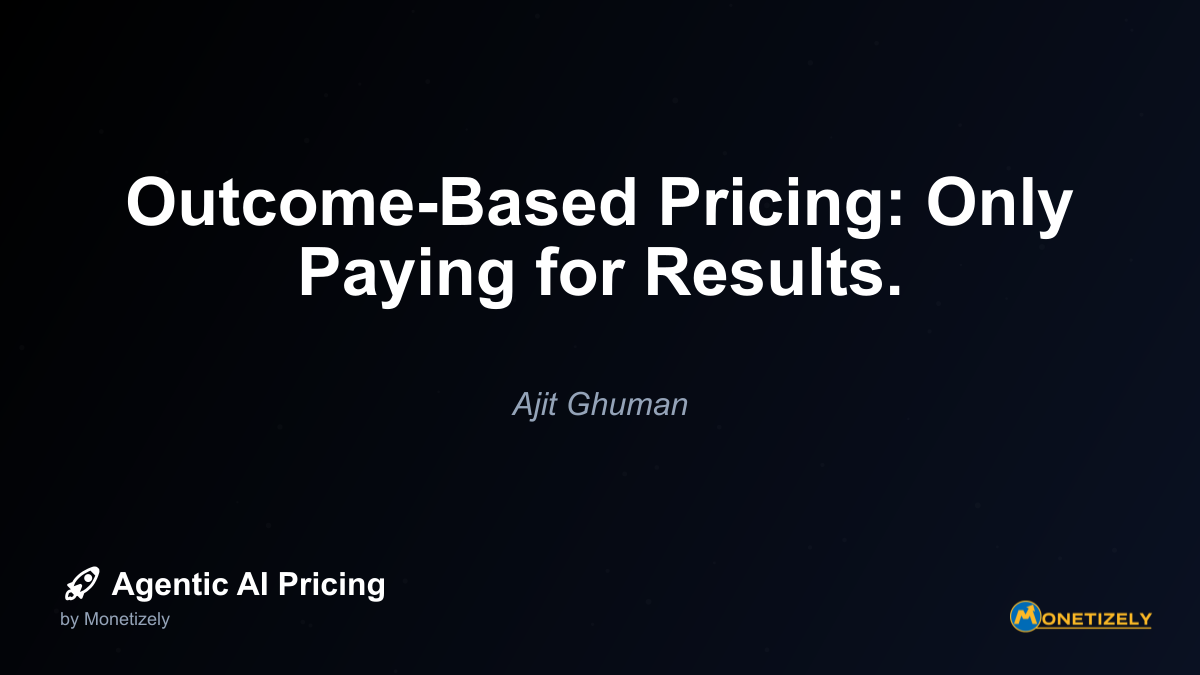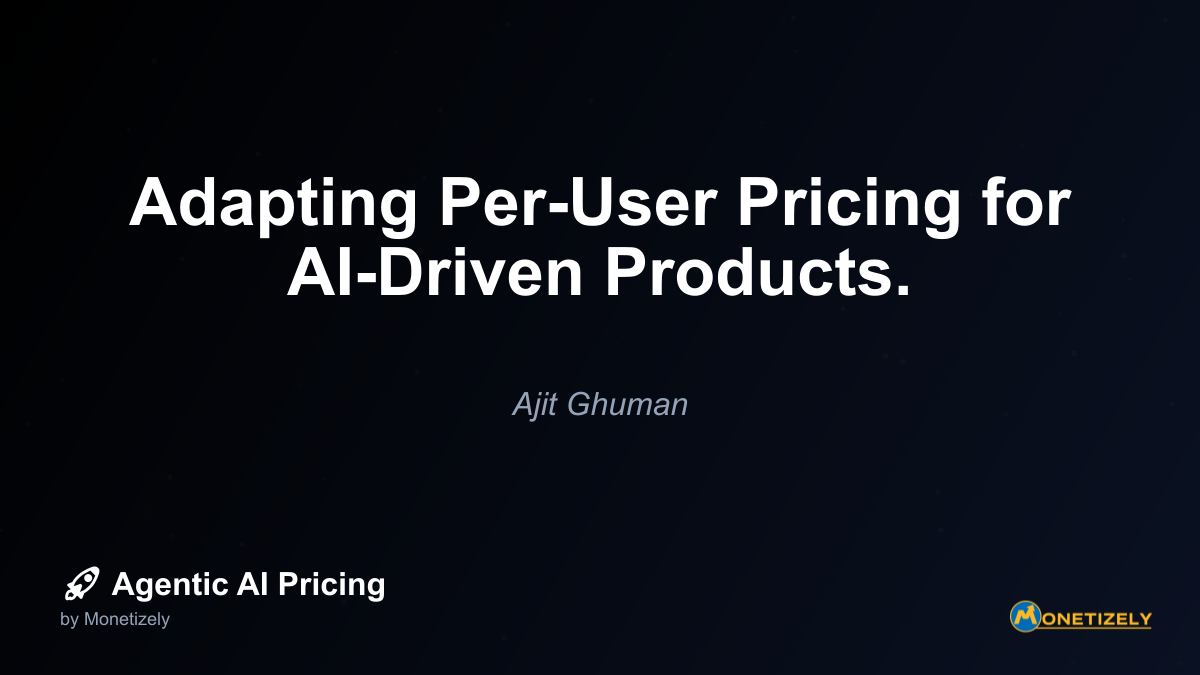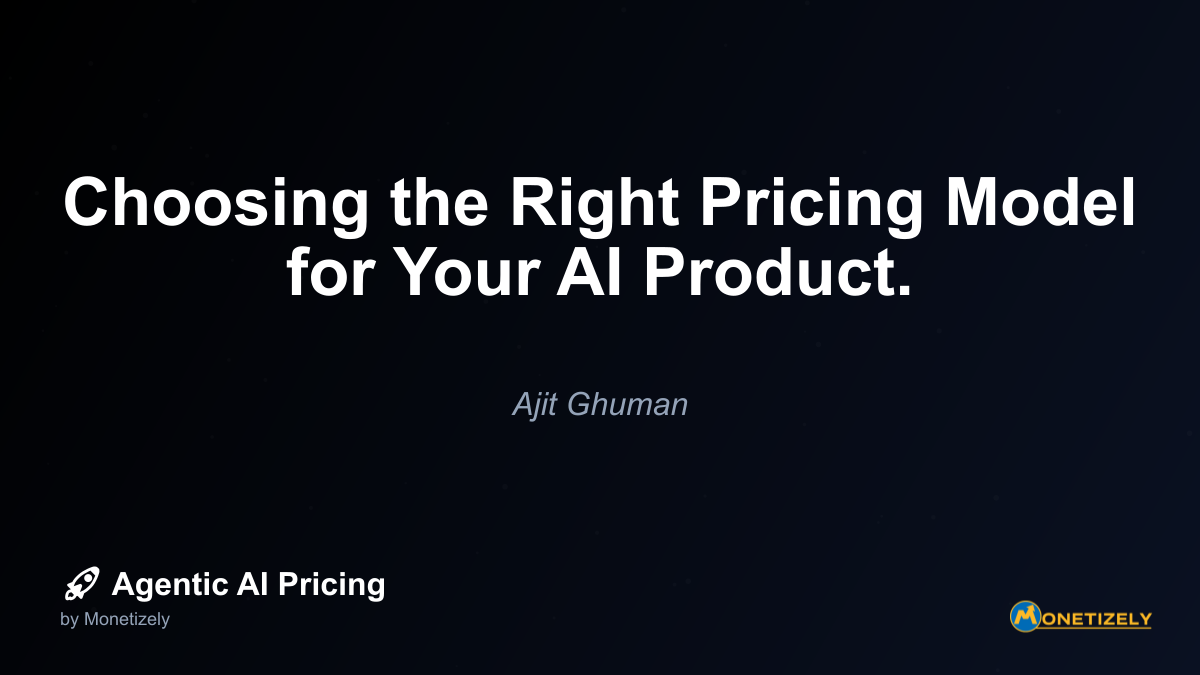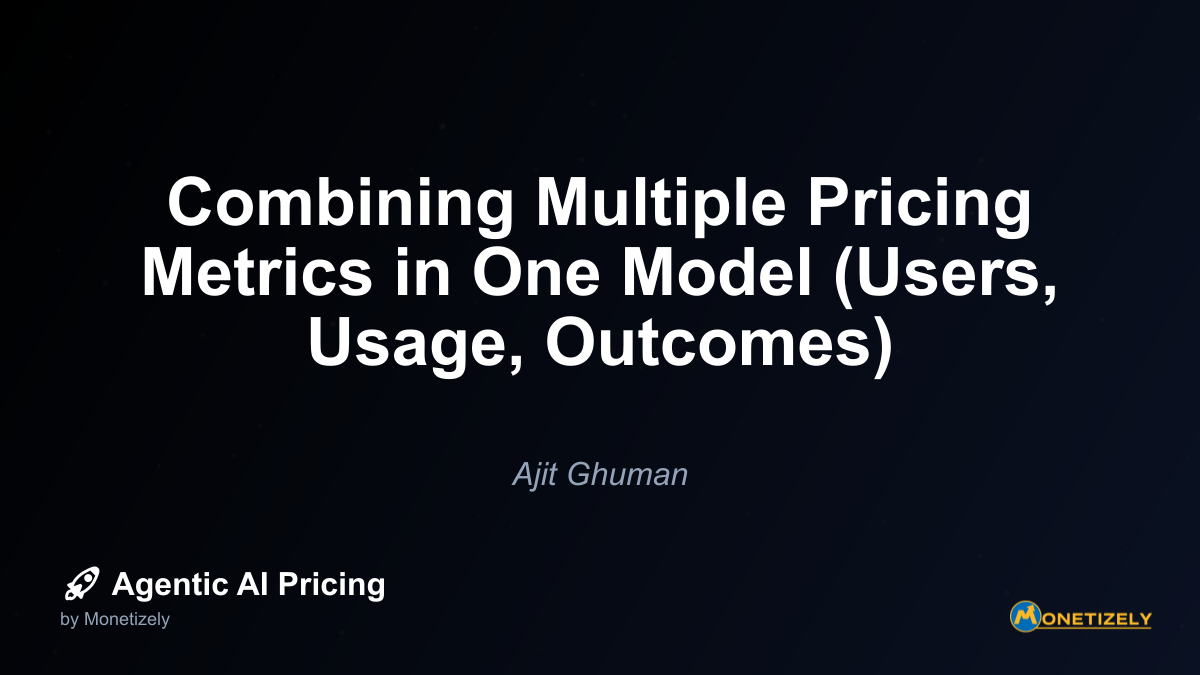· Akhil Gupta · Agentic AI Pricing Strategies · 9 min read
Ensuring Profitability in Outcome-Based Deals.
AI and SaaS Pricing Masterclass
Learn the art of strategic pricing directly from industry experts. Our comprehensive course provides frameworks and methodologies for optimizing your pricing strategy in the evolving AI landscape. Earn a professional certification that can be imported directly to your LinkedIn profile.
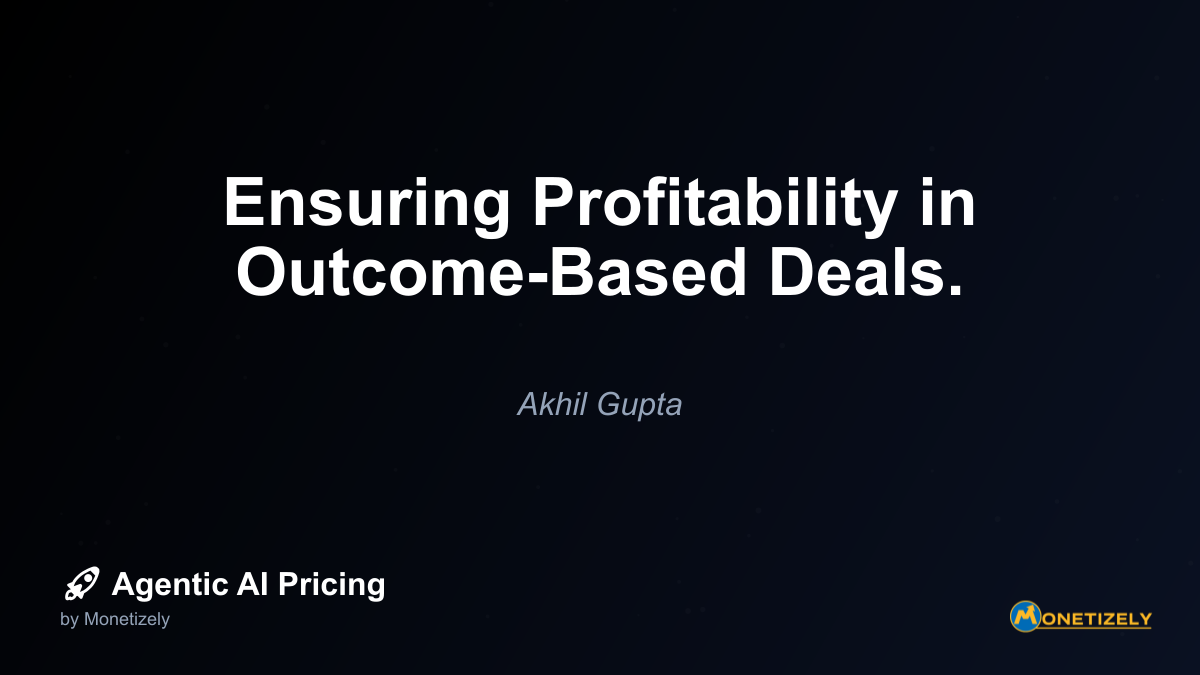
Outcome-based pricing models are gaining significant traction in the agentic AI space, offering the allure of aligning vendor compensation directly with customer success. However, this approach comes with substantial risks to profitability if not structured carefully. While customers may be drawn to the “pay for results” concept, vendors must implement strategic guardrails to ensure sustainable business operations. The delicate balance lies in creating frameworks that deliver genuine value to customers while maintaining healthy profit margins for providers.
The Fundamentals of Outcome-Based Pricing in Agentic AI
Outcome-based pricing represents a paradigm shift from traditional subscription or usage-based models. Instead of charging for access to technology or features, vendors tie compensation directly to the achievement of specific business outcomes. This approach is particularly relevant for agentic AI solutions, where autonomous systems can deliver measurable business impact across various domains.
The core principle is straightforward: the vendor gets paid based on results delivered rather than resources consumed. For example, an agentic AI system for procurement might be priced based on cost savings identified, while a customer service AI could be priced on resolution rates or customer satisfaction improvements.
This model offers compelling advantages:
- Creates perfect alignment between vendor and customer success
- Reduces perceived risk for customers hesitant about AI investments
- Potentially enables premium pricing when outcomes exceed expectations
- Differentiates offerings in competitive markets
However, without proper safeguards, outcome-based pricing can quickly erode profits or create unsustainable business dynamics. The remainder of this article explores proven strategies to maintain profitability while delivering on the promise of outcome-based models.
Why Establish Baseline Fees?
The foundation of a profitable outcome-based pricing structure begins with establishing non-negotiable baseline fees. These represent the minimum compensation required to cover fundamental costs regardless of outcome achievement.
Baseline fees serve several critical purposes:
Cost Recovery: They ensure coverage of implementation, infrastructure, and ongoing operational expenses regardless of outcome achievement.
Risk Mitigation: They provide financial stability during periods when outcomes might be delayed or underperforming.
Value Recognition: They acknowledge that your solution delivers inherent value beyond purely measurable outcomes.
When determining appropriate baseline fees, consider:
- Direct costs of service delivery (infrastructure, support, maintenance)
- Minimum viable revenue needed for sustainable operations
- Industry benchmarks for similar solutions
- Customer’s perceived value of core functionality
The ideal baseline fee structure typically represents 40-60% of the total potential compensation, though this varies by industry and solution type. This creates a healthy balance where vendors have financial security while maintaining significant upside potential tied to performance.
For example, an agentic AI sales assistant might charge a $2,000 monthly baseline fee plus 5% of incremental revenue generated above established thresholds. This ensures the vendor can sustain operations even during slower sales periods while maintaining strong incentives for performance optimization.
Defining Outcomes with Precision
Perhaps the most crucial element of profitable outcome-based pricing is the meticulous definition of what constitutes a billable “outcome.” Ambiguity in outcome definitions creates substantial financial risk and potential disputes that can damage customer relationships.
Effective outcome definitions should include:
Quantifiable Metrics with Clear Measurement Methodologies
Specify exactly what will be measured and how. For instance, rather than vague terms like “improved efficiency,” define “reduction in average processing time from receipt of customer inquiry to final resolution, measured in business hours, excluding weekends and holidays, calculated as a monthly average.”
Established Baselines and Benchmarking Periods
Before implementing outcome-based pricing, establish reliable baselines through:
- Historical data analysis (minimum 3-6 months recommended)
- Controlled A/B testing during implementation
- Industry benchmarks when historical data is unavailable
Document these baselines thoroughly and gain explicit customer agreement on methodology and results before finalizing pricing terms.
Attribution Rules
Clearly articulate how outcomes will be attributed to your solution versus other factors. This is particularly important in complex environments where multiple systems or process changes might impact results.
Consider including:
- Specific attribution models
- Controls for external variables
- Adjustment mechanisms for organizational changes
Measurement Frequency and Payment Timing
Define when and how often outcomes will be measured, and establish clear timelines for when payments based on those measurements become due. Monthly measurement with quarterly reconciliation often provides a good balance between responsiveness and administrative efficiency.
Implementing Tiered Pricing Structures
Tiered outcome-based pricing creates natural profitability protections while incentivizing exceptional performance. This approach establishes different compensation rates based on performance levels, typically with higher margins at higher performance tiers.
A basic tiered structure might include:
- Base Tier: Covers outcomes up to an expected performance level with modest margin
- Performance Tier: Rewards above-average results with improved margins
- Excellence Tier: Provides premium compensation for exceptional outcomes
For example, an agentic AI for marketing campaign optimization might use this structure:
- 10% of incremental revenue for the first $100,000 in improvements
- 15% for the next $100,000-$500,000
- 20% for anything above $500,000
This approach ensures that as your solution delivers increasingly valuable outcomes, your profit margins expand accordingly. It also creates natural caps on compensation that prevent runaway costs for customers while allowing vendors to capture appropriate value from exceptional performance.
Setting Performance Caps and Floors
While outcome-based pricing should reward exceptional performance, unbounded upside can create customer anxiety or lead to contract renegotiation when success exceeds expectations. Similarly, protection against extreme underperformance is essential for vendor sustainability.
Performance caps and floors address these concerns:
Performance Caps
Establish maximum compensation levels that apply regardless of outcomes achieved. These caps should be set high enough to maintain performance incentives while providing customers with predictable maximum costs.
Effective approaches include:
- Fixed dollar caps (e.g., “not to exceed $50,000 per month”)
- Percentage-based caps (e.g., “not to exceed 300% of baseline fee”)
- Declining percentage rates at higher performance levels
Performance Floors
Protect against extreme underperformance with minimum compensation requirements. These might include:
- Minimum outcome thresholds that trigger baseline compensation
- Guaranteed minimum payments regardless of outcomes
- Termination rights if performance consistently falls below defined thresholds
Performance floors are particularly important during initial implementation periods when systems are being optimized and baseline data may be unreliable.
Addressing Non-Performance by Clients
Outcome achievement often depends on factors beyond the vendor’s direct control. Customer cooperation, data quality, process adherence, and organizational changes can all significantly impact results. Without appropriate protections, vendors may be financially penalized for customer-caused non-performance.
Essential contractual protections include:
Clearly Defined Client Responsibilities
Document specific customer obligations that impact outcome achievement, such as:
- Data provision requirements (quality, format, timeliness)
- System access and availability expectations
- Required approvals and decision timeframes
- Staff training and utilization requirements
Remediation Processes
Establish formal processes for addressing client non-performance:
- Notification requirements and formats
- Remediation periods with specific timelines
- Escalation procedures for unresolved issues
- Compensation adjustments during remediation periods
Force Majeure Provisions
Include provisions that address major disruptions beyond either party’s control:
- Market disruptions
- Regulatory changes
- Significant organizational restructuring
- External crises affecting normal operations
These provisions should temporarily modify outcome expectations or revert to alternative pricing models during the affected period.
Managing Extreme Scenarios with Special Clauses
Outcome-based pricing requires careful consideration of edge cases and extreme scenarios that could dramatically impact profitability. Proactive contractual provisions addressing these possibilities can prevent significant financial exposure.
Key clauses to consider include:
Windfall Provisions
These clauses address situations where extraordinary results occur due to factors largely unrelated to your solution’s performance. For example, if a customer experiences a 500% growth due to market conditions or acquisition, windfall provisions might cap outcome-based payments or trigger renegotiation.
Material Change Provisions
These provisions address significant changes to the customer’s business that fundamentally alter the context in which outcomes are measured. Triggering events might include:
- Mergers or acquisitions
- Major product launches or discontinuations
- Entry into or exit from markets
- Leadership changes affecting strategic direction
When triggered, these clauses typically require good-faith renegotiation of outcome definitions and compensation structures.
Early Termination Protections
Outcome-based pricing often involves significant upfront investment with returns realized over time. Early termination protections ensure appropriate compensation if customers terminate prematurely:
- Accelerated payment of minimum fees for remaining term
- Compensation for unrealized outcome-based revenue
- Transition fees covering knowledge transfer and data extraction
These protections are particularly important for complex agentic AI implementations with substantial upfront customization and training requirements.
Leveraging Data Rights for Additional Revenue
Agentic AI systems generate valuable operational and performance data beyond the primary outcomes being measured. Strategic data rights provisions can create additional revenue streams and profitability enhancements.
Consider these approaches:
Anonymized Benchmarking Rights
Retain rights to use anonymized performance data for industry benchmarking, which can:
- Create valuable competitive intelligence products
- Enhance marketing and sales effectiveness
- Improve solution performance across customers
Model Improvement Rights
Secure rights to use operational data for model improvement, which delivers:
- Enhanced performance for all customers
- Reduced development costs for new features
- Competitive differentiation through continuous improvement
Derivative Product Development
Establish rights to develop new products based on insights gained, potentially creating:
- Adjacent revenue streams
- Upsell opportunities
- Market expansion possibilities
While monetizing these rights directly may be challenging, they represent significant value that should be factored into overall pricing strategy and profitability calculations.
Practical Implementation Timeline
Implementing profitable outcome-based pricing typically follows this progression:
Phase 1: Discovery and Baseline Establishment (1-3 months)
- Conduct detailed discovery of customer environment
- Establish reliable performance baselines
- Document current state processes and metrics
- Identify potential implementation challenges
Phase 2: Pilot Implementation (2-4 months)
- Deploy solution in controlled environment
- Validate measurement methodologies
- Refine outcome definitions based on real-world data
- Adjust baseline fees based on implementation realities
Phase 3: Full Deployment with Hybrid Pricing (3-6 months)
- Implement solution across entire scope
- Apply hybrid pricing with higher baseline/lower outcome components
- Gather comprehensive performance data
- Establish reliable attribution methodologies
Phase 4: Optimized Outcome-Based Pricing (Ongoing)
- Transition to target baseline/outcome ratio
- Implement tiered pricing based on performance data
- Continuously refine measurement and attribution
- Regular review and adjustment of performance thresholds
This phased approach minimizes risk while providing both parties with increasing confidence in the outcome measurement and compensation structure.
Conclusion: Balancing Risk and Reward
Outcome-based pricing offers compelling advantages for both vendors and customers in the agentic AI space, but profitability depends on thoughtful structure and implementation. The most successful models create genuine alignment while incorporating appropriate protections for both parties.
Key takeaways for maintaining profitability include:
- Establish meaningful baseline fees that cover core costs and provide financial stability
- Define outcomes with extreme precision to prevent disputes and ambiguity
- Implement tiered structures that enhance margins as performance improves
- Set appropriate caps and floors to manage expectations and limit exposure
- Address client non-performance with clear responsibilities and remediation processes
- Prepare for extreme scenarios with specific contractual provisions
- Consider data rights as additional value components in overall profitability
By applying these principles, vendors can confidently offer outcome-based pricing that delivers on its promise: aligning compensation with customer success while maintaining healthy, sustainable profit margins. The future of agentic AI pricing will increasingly incorporate these models, with the most sophisticated vendors finding the optimal balance between risk-sharing and profitability protection.
Co-Founder & COO
Akhil is an Engineering leader with over 16+ years of experience in building, managing and scaling web-scale, high throughput enterprise applications and teams. He has worked with and led technology teams at FabAlley, BuildSupply and Healthians. He is a graduate from Delhi College of Engineering and UC Berkeley certified CTO.
Pricing Strategy Audit
Let our experts analyze your current pricing strategy and identify opportunities for improvement. Our data-driven assessment will help you unlock untapped revenue potential and optimize your AI pricing approach.

